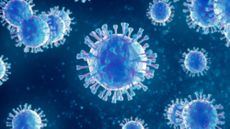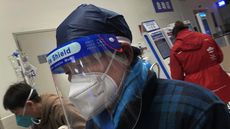The latest Covid testing rules explained
Asymptomatic people will no longer need to confirm a positive lateral flow test with a PCR

Follow-up PCR tests to confirm Covid-19 infections in asymptomatic people are being axed in a bid to shorten isolation periods and ease nationwide staffing shortages.
The UK Health Security Agency has confirmed that from 11 January, PCRs will no longer be required for anyone in England who gets a positive on a lateral flow test but has no symptoms – “said to be around 40% of those with the virus”, according to The Mirror.
These people “will still have to isolate for at least seven days, but only from the date of their positive lateral flow test”, the paper reported.
Subscribe to The Week
Escape your echo chamber. Get the facts behind the news, plus analysis from multiple perspectives.

Sign up for The Week's Free Newsletters
From our morning news briefing to a weekly Good News Newsletter, get the best of The Week delivered directly to your inbox.
From our morning news briefing to a weekly Good News Newsletter, get the best of The Week delivered directly to your inbox.
What are the current rules on testing and self-isolation?
Current NHS guidance for England says that people who test positive on a lateral flow test should take a PCR test and then self-isolate for a maximum of ten days if confirmed to have Covid.
PCR tests are also advised for anyone who:
- has any of the three main symptoms of Covid-19: a high temperature, a new, continuous cough, or a loss or change to sense of smell or taste
- has recorded a void LFT
- is unvaccinated and has come into close contact with someone who has tested positive for Covid. But fully vaccinated adults only need to carry out daily LFTs for seven days if a close contact has tested positive.
Last month, the government reduced the isolation period from ten days to seven days for people who test negative in two lateral flow tests taken 24 hours apart on days six and seven and who do not have symptoms or a high temperature.
Sign up for Today's Best Articles in your inbox
A free daily email with the biggest news stories of the day – and the best features from TheWeek.com
The reduced isolation period only applies in England. In Scotland, Wales and Northern Ireland, the isolation period remains ten days.
What has changed?
Asymptomatic people will no longer have to book a follow–up PCR test under the rule change, which applies from 11 January in England and from tomorrow in Wales and Scotland.
These people will still be required to isolate for at least seven days – until they have produced two negative LFTs on days six and seven – but only from the date of their initial positive LFT test.
The change is intended to further cut isolation times for asymptomatic people, who currently have to start their isolation period from the day that they get a positive PCR result.
People with Covid symptoms will still be required to take a PCR test, regardless of whether they have taken a lateral flow test.
Ministers believe scrapping the requirement for a follow-up PCR will “help ease the burden of the current staff shortages crippling the UK”, said the i news site. The NHS, schools and refuse collection services have been “plagued by high numbers of staff absences” fuelled by the spread of the highly contagious Omicron strain and self-isolation rules.
The Telegraph said that “fears are growing that staff absences have become as big a problem as Covid itself, with bin collections delayed, trains cancelled and 17 hospitals in Greater Manchester announcing on Tuesday that they would be suspending some non-urgent surgery, with 15% of staff off sick”.
Health minister Gillian Keegan told Sky News today that “around a million people” in the UK were currently self-isolating.
The latest rule changes are expected to be “only temporary”, according to The Mirror, which reported that follow-up PCR tests were expected to be reintroduced when the “worst of the Omicron wave passes”.
“PCR tests will be restored when prevalence dips back to or below around 1%,” said the paper, which added that current levels are “thought to be 4% or more”.
Create an account with the same email registered to your subscription to unlock access.
-
 Nigeria's worsening rate of maternal mortality
Nigeria's worsening rate of maternal mortalityUnder the radar Economic crisis is making hospitals unaffordable, with women increasingly not receiving the care they need
By Harriet Marsden, The Week UK Published
-
 'Elevating Earth Day into a national holiday is not radical — it's practical'
'Elevating Earth Day into a national holiday is not radical — it's practical'Instant Opinion Opinion, comment and editorials of the day
By Harold Maass, The Week US Published
-
 UAW scores historic win in South at VW plant
UAW scores historic win in South at VW plantSpeed Read Volkswagen workers in Tennessee have voted to join the United Auto Workers union
By Peter Weber, The Week US Published
-
 Covid four years on: have we got over the pandemic?
Covid four years on: have we got over the pandemic?Today's Big Question Brits suffering from both lockdown nostalgia and collective trauma that refuses to go away
By Chas Newkey-Burden, The Week UK Published
-
 The hollow classroom
The hollow classroomOpinion Remote school let kids down. It will take much more than extra tutoring for kids to recover.
By Mark Gimein Published
-
 Excess screen time is making children only see what is in front of them
Excess screen time is making children only see what is in front of themUnder the radar The future is looking blurry. And very nearsighted.
By Devika Rao, The Week US Published
-
 Covid-19: what to know about UK's new Juno and Pirola variants
Covid-19: what to know about UK's new Juno and Pirola variantsin depth Rapidly spreading new JN.1 strain is 'yet another reminder that the pandemic is far from over'
By Arion McNicoll, The Week UK Published
-
 Long-term respiratory illness is here to stay
Long-term respiratory illness is here to stayThe Explainer Covid is not the only disease with a long version
By Devika Rao, The Week US Published
-
 Covid inquiry: the most important questions for Boris Johnson
Covid inquiry: the most important questions for Boris JohnsonTalking Point Former PM has faced weeks of heavy criticism from former colleagues at the public hearing
By The Week Staff Published
-
 China's pneumonia cases: should we be worried?
China's pneumonia cases: should we be worried?The Explainer Experts warn against pushing 'pandemic panic button' following outbreak of respiratory illness
By Keumars Afifi-Sabet, The Week UK Published
-
 Vallance diaries: Boris Johnson 'bamboozled' by Covid science
Vallance diaries: Boris Johnson 'bamboozled' by Covid scienceSpeed Read Then PM struggled to get his head around key terms and stats, chief scientific advisor claims
By The Week UK Published